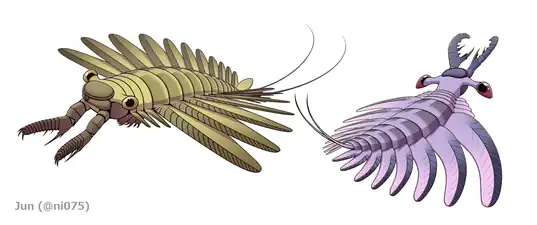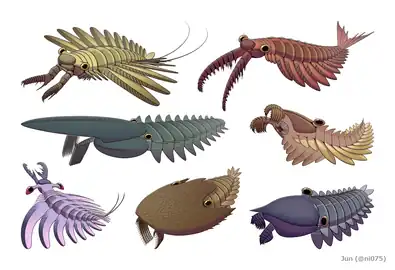Amplectobeluidae
Amplectobeluidae is a clade of Cambrian radiodonts.
| Amplectobeluidae | |
|---|---|
 | |
| Amplectobelua (left) and Lyrarapax (right) | |
| Scientific classification | |
| Domain: | Eukaryota |
| Kingdom: | Animalia |
| Phylum: | Arthropoda |
| Class: | †Dinocaridida |
| Order: | †Radiodonta |
| Clade: | †Amplectobeluidae Pates et al., 2019 |
| Genera | |
Definition
In 2014, Amplectobeluidae was defined as the most inclusive clade including Amplectobelua symbrachiata but not Anomalocaris canadensis, Tamisiocaris borealis, or Hurdia victoria.[1]
Description
Amplectobeluids could be recognized by frontal appendages with well-developed first distal endite, which forming a pincer-like structure that presumably better suited for a grasping function.[1][2] Complete body fossils of amplectobeluids are only known by Amplectobelua and Lyrarapax, both showing combination of characters resembling Anomalocaris (i.e. streamlined body; small head with ovoid sclerites; well-developed swimming flaps; a pair of caudal furcae).[3][4][5][6][7] Another distinctive features only known in amplectobeluid genera were pairs of gnathobase-like structures (known by Amplectobelua and Ramskoeldia),[6][8] or an oral cone with combination of tetraradial arrangement and scale-like nodes (known by Lyrarapax and "Anomalocaris" kunmingensis).[5][9][10]
Classification
Early in 2014, "Anomalocaris" kunmingensis was tentatively assigned to Amplectobelua by Vinther et al.[1] Later that year, however, the discoverers of Lyrarapax unguispinus ignored that assessment and created a genus within Amplectobelua sensu Vinther et al.[4] Indeterminate frontal appendages assignable to this group are known from the Parker Formation of Vermont.[11]
Phylogeny
An a posteriori-weighted phylogenetic analysis in 2014 found the following relationships within the Amplectobeluidae:[4]
| |||||||||||||||||||
| |||||||||||||||||||
References
- Vinther J, Stein M, Longrich NR, Harper DA (March 2014). "A suspension-feeding anomalocarid from the Early Cambrian" (PDF). Nature. 507 (7493): 496–9. Bibcode:2014Natur.507..496V. doi:10.1038/nature13010. PMID 24670770. S2CID 205237459.
- Daley AC, Paterson JR, Edgecombe GD, García-Bellido DC, Jago JB (2013). "New anatomical information on Anomalocaris from the Cambrian Emu Bay Shale and a reassessment of its inferred predatory habits". Palaeontology. 56 (5): 971–990. doi:10.1111/pala.12029.
- Chen JY, Ramsköld L, Zhou GQ (May 1994). "Evidence for monophyly and arthropod affinity of Cambrian giant predators". Science. 264 (5163): 1304–8. Bibcode:1994Sci...264.1304C. doi:10.1126/science.264.5163.1304. PMID 17780848. S2CID 1913482.
- Cong P, Ma X, Hou X, Edgecombe GD, Strausfeld NJ (September 2014). "Brain structure resolves the segmental affinity of anomalocaridid appendages". Nature. 513 (7519): 538–42. Bibcode:2014Natur.513..538C. doi:10.1038/nature13486. PMID 25043032. S2CID 4451239.
- Liu J, Lerosey-Aubril R, Steiner M, Dunlop JA, Shu D, Paterson JR (2018-11-01). "Origin of raptorial feeding in juvenile euarthropods revealed by a Cambrian radiodontan". National Science Review. 5 (6): 863–869. doi:10.1093/nsr/nwy057. ISSN 2095-5138.
- Cong P, Daley AC, Edgecombe GD, Hou X (August 2017). "The functional head of the Cambrian radiodontan (stem-group Euarthropoda) Amplectobelua symbrachiata". BMC Evolutionary Biology. 17 (1): 208. doi:10.1186/s12862-017-1049-1. PMC 5577670. PMID 28854872.
- Moysiuk J, Caron JB (August 2019). "A new hurdiid radiodont from the Burgess Shale evinces the exploitation of Cambrian infaunal food sources". Proceedings. Biological Sciences. 286 (1908): 20191079. doi:10.1098/rspb.2019.1079. PMC 6710600. PMID 31362637.
- Cong PY, Edgecombe GD, Daley AC, Guo J, Pates S, Hou XG (2018). "New radiodonts with gnathobase-like structures from the Cambrian Chengjiang biota and implications for the systematics of Radiodonta" (PDF). Papers in Palaeontology. 4 (4): 605–621. doi:10.1002/spp2.1219. ISSN 2056-2802. S2CID 90258934.
- Zeng H, Zhao F, Yin Z, Zhu M (2018). "A new radiodontan oral cone with a unique combination of anatomical features from the early Cambrian Guanshan Lagerstätte, eastern Yunnan, South China". Journal of Paleontology. 92 (1): 40–48. Bibcode:2018JPal...92...40Z. doi:10.1017/jpa.2017.77. ISSN 0022-3360. S2CID 134157062.
- Jiao DG, Pates S, Lerosey-Aubril R, Ortega-Hernández J, Yang J, Lan T, Zhang XG (2021). "The endemic radiodonts of the Cambrian Stage 4 Guanshan biota of South China". Acta Palaeontologica Polonica. 66. doi:10.4202/app.00870.2020. ISSN 0567-7920.
- Pari, Giovanni; Briggs, Derek E.G.; Gaines, Robert R. (2022-02-16). "The soft-bodied biota of the Cambrian Series 2 Parker Quarry Lagerstätte of northwestern Vermont, USA". Journal of Paleontology. 96 (4): 770–790. Bibcode:2022JPal...96..770P. doi:10.1017/jpa.2021.125. ISSN 0022-3360. S2CID 246933116.
